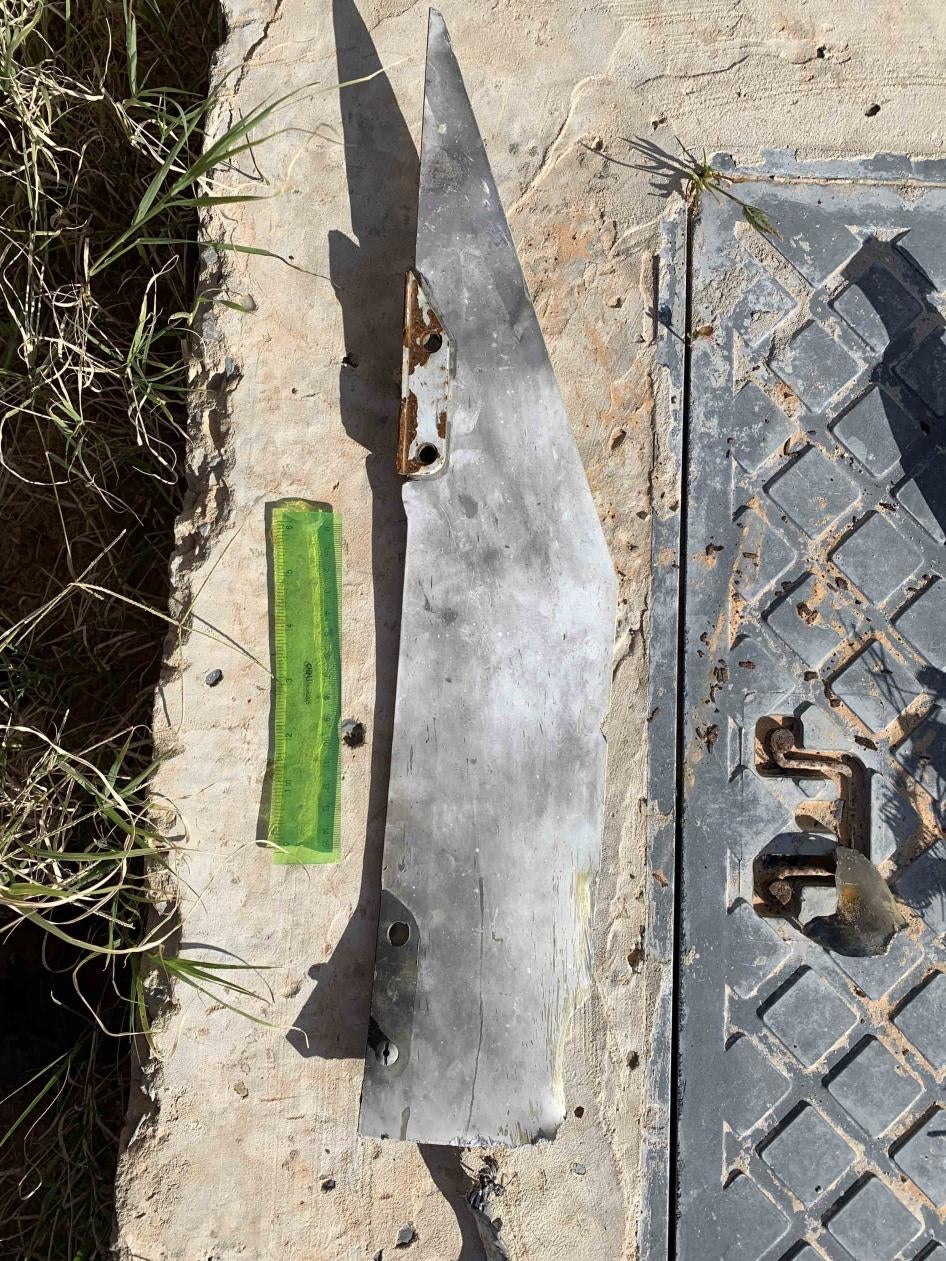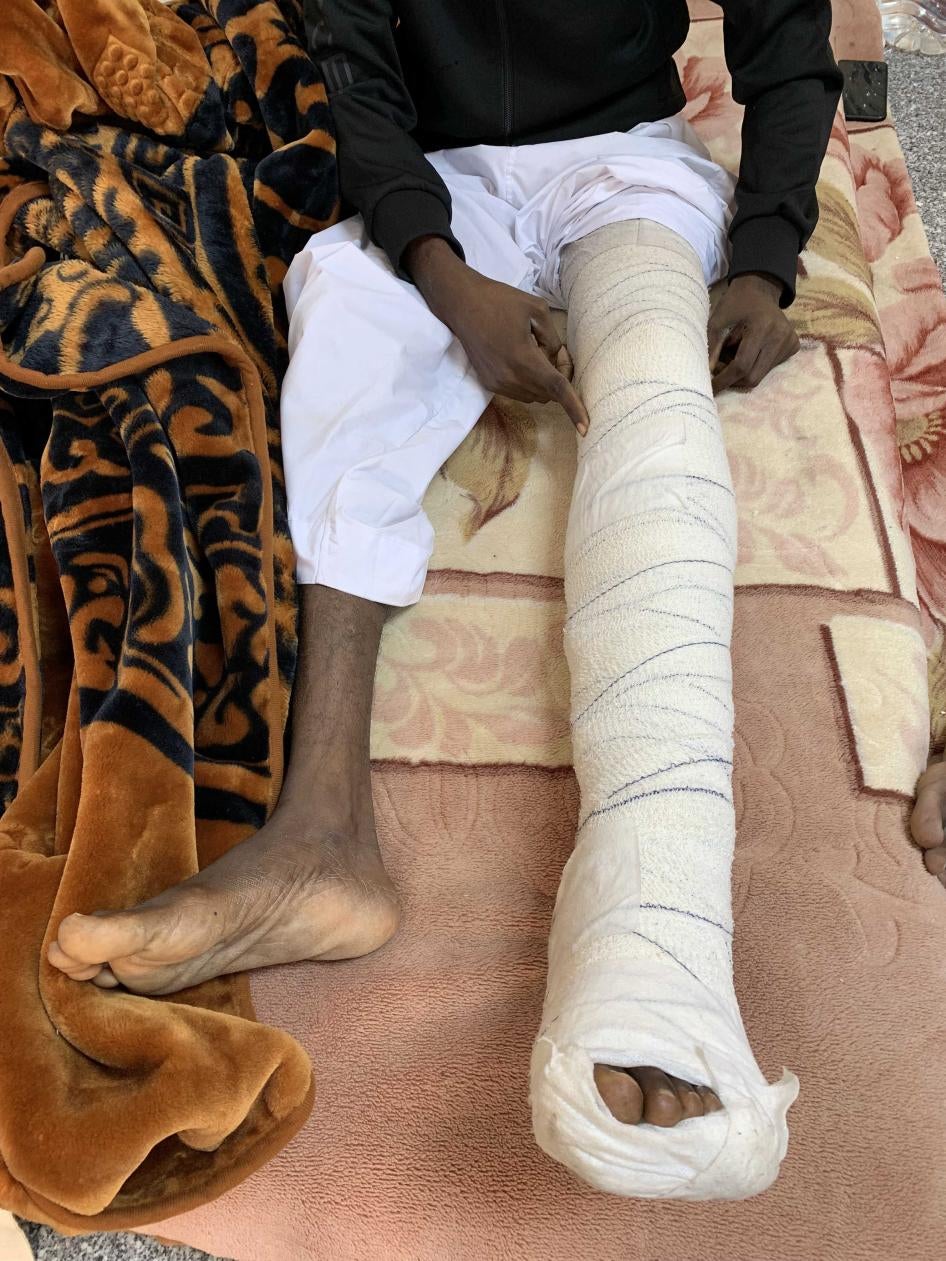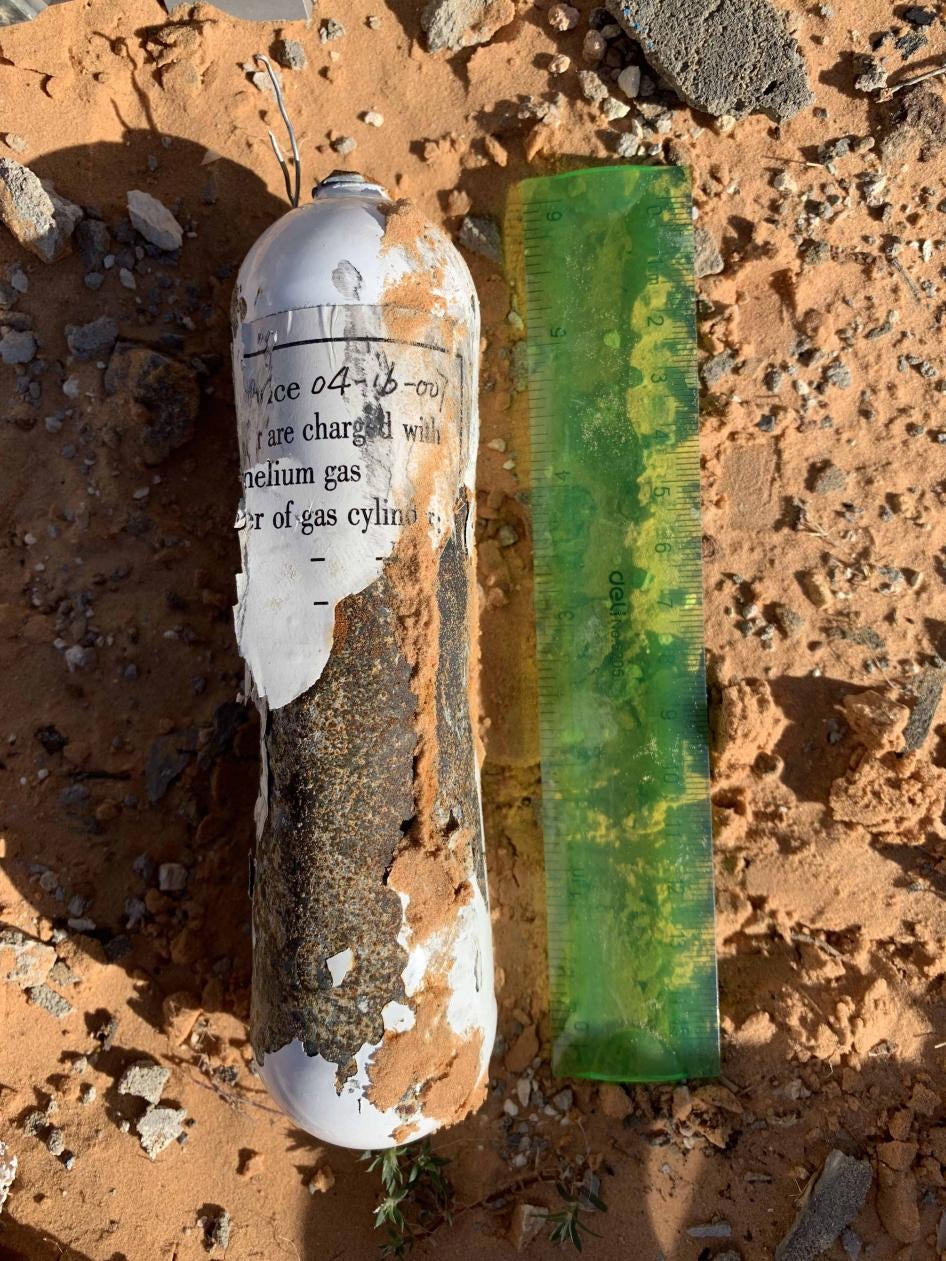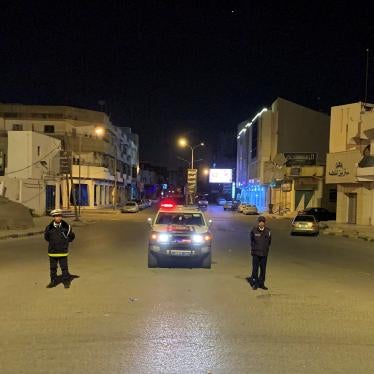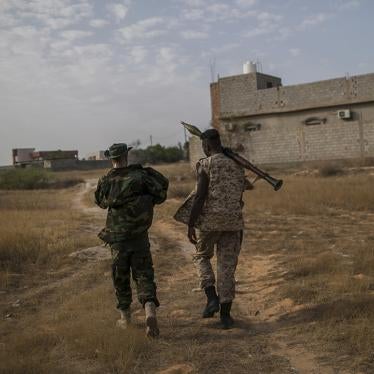(Beirut) – An apparently unlawful drone attack by the United Arab Emirates that hit the Al-Sunbulah biscuit factory in Wadi al-Rabie, Libya, south of Tripoli, on November 18, 2019, killed 8 civilians and wounded 27, Human Rights Watch said today, after investigating the incident. The UAE appeared to take little or no action to minimize harm to civilians in its attack and should conduct a transparent investigation of this incident, make the results public, and compensate victims or their families.
Since the current armed conflict in Tripoli erupted in April 2019, the UAE has been conducting air and drone strikes to support the Libyan Arab Armed Forces (LAAF), previously known as the Libyan National Army, one of two major Libyan parties to the conflict, some of which have resulted in civilian casualties. All casualties in the November incident were civilian factory workers, including 7 Libyans and 28 foreign nationals, all of them men.
“The UAE attacked a factory that makes food products, with no indication there were any military targets,” said Eric Goldstein, acting Middle East and North Africa director at Human Rights Watch. “The failure to verify that the workers there were civilians and that there was no legitimate military target would show recklessness and bad intelligence.”
A Human Rights Watch researcher visited the scene of the attack in December 2019 and documented material damage to the factory from drone-launched guided missiles and found remnants of the weapons. Human Rights Watch did not observe any military targets in the area. The strikes damaged the building and destroyed a truck and a car. The factory stopped operating after the attack.
At the strike site, Human Rights Watch found remnants of at least four Blue Arrow-7 (BA-7) laser-guided missiles that were launched by a Wing Loong-II drone. In Libya only the UAE uses this type of drone and missile.
Human Rights Watch interviewed five people who had been at the site, who said there were five missiles, all launched within a few minutes. The researcher met with two employees of Al-Sunbulah company who were present on the day of the strike and with three other employees who had been injured during the attack and were recovering at a nearby facility belonging to the company.
The attack site is a factory compound with several industrial hangars mostly used as warehouses to store raw materials and equipment. The company produces over 20 types of food items. The surrounding area was mostly farmland, although Human Rights Watch saw some individual houses and other factories – including a paper napkin factory and a wheat mill – that were not near each other.
Satellite imagery taken since early April 2019 shows construction of a possible checkpoint on the main road running alongside the factory compound, about 75 meters east of the Omar Ibn al-Khatab mosque. Imagery since February 2020 shows barriers on the road in the vicinity of the possible checkpoint. When Human Rights Watch visited the site in December 2019 researchers saw no sign that armed groups had been at the facility. The employees interviewed said the closest military presence at the time of the attack was a field hospital at a different mosque at least 1.5 kilometers away. At the time of the visit, the researcher heard artillery shelling in the distance and employees said that the front line was 5 to 6 kilometers away.
A Human Rights Watch researcher visited the scene of the attack in December 2019, documented material damage to the factory from drone-launched guided missiles and found remnants of the weapons as shown in this interactive map.
Four of the employees said that seven of their co-workers died on the spot and that the eighth – from Bangladesh – died from his wounds about 10 days later in a Tripoli hospital. The UAE has not publicly commented on its role in the attack or offered compensation for the civilian losses.
According to media, UN, and other reports, the UAE has carried out at least five other strikes that resulted in civilian casualties since April 2019. These include a July attack against a migrant detention center in Tajoura, near Tripoli, that killed at least 50 migrants and asylum seekers of various nationalities. In addition to drones, the UAE has supplied the LAAF with weapons, ammunition, and other combat materials such as armored vehicles, in violation of a 2011 UN Security Council arms embargo that prohibits such transfers, according to reports from the UN Panel of Experts on Libya.
The UAE’s sustained military support for the LAAF, an eastern armed group with a well-established record of serious laws of war and human rights abuses, risks making the UAE complicit in these abuses and could expose it to scrutiny by international investigations, Human Rights Watch said. Human Rights Watch wrote to UAE authorities on April 17, 2020 requesting information about any investigation they may have conducted into the drone strikes of November 18 and any steps taken to minimize civilian harm; as of the time of publication we received no response.
Governance in Libya remains divided between two entities engaged in an armed conflict since April 2019: the internationally recognized and Tripoli-based Government of National Accord and the rival Interim Government based in eastern Libya that is affiliated with the (LAAF). Calls by United Nations Secretary-General Antonio Guterres and others for a “humanitarian pause” in the armed conflict to allow authorities to respond to the Covid-19 pandemic that has started to spread in the country have so far gone unheeded.
To help end the cycle of impunity in Libya, the UN Human Rights Council in Geneva should, during its upcoming session in June, establish an International Commission of Inquiry to document violations, identify those responsible, including external actors, preserve evidence where possible for future criminal proceedings, and publicly report on the human rights situation in Libya, Human Rights Watch said.
All parties to the conflict in Libya are obliged to abide by the laws of war. Civilians and civilian objects may never be the object of attacks. Warring parties are required to take all feasible precautions to minimize harm to civilians and civilian objects and to refrain from attacks that would disproportionately harm civilians or fail to discriminate between combatants and civilians.
Those who commit, order, assist, or have command responsibility for war crimes in Libya are subject to prosecution by domestic courts or the International Criminal Court, which has a mandate over war crimes, crimes against humanity, and genocide committed there since February 15, 2011.
“UAE drones and planes have been pounding Tripoli for a year now with apparent scant respect for civilian life,” Goldstein said. “There is a pressing need for the United Nations Human Rights Council to scrutinize the UAE’s bloody record in Libya.”
Parties to the Conflict
One of the two major opposing Libyan parties to the conflict, the eastern-based Libyan Arab Armed Forces (LAAF), under the command of Khalifa Hiftar, is supported by multiple armed groups, including from along the western Libyan coastal towns of Sebratha and Sorman, and from Tarhouna. On April 13, the internationally recognized Government of National Accord pushed Hiftar’s forces out of the western coastal towns and regained control. Militias with a strict Salafi Islamist agenda also support the LAAF.
The group has received military support from the United Arab Emirates (UAE), Jordan, and Egypt despite the Libya arms embargo. The UAE operates a military airbase in eastern Libya, supplies weapons and ammunition to the LAAF, and its warplanes and armed drones have operated in support of the LAAF. Foreign fighters from Sudan and Chad and Russian fighters from a private security company reportedly support the armed group. Syrian fighters backed by Russia also reportedly support the group in Libya.
On the opposing side are the Tripoli-based Government of National Accord and affiliated armed groups from western Libya. Turkey, now also a party to the conflict, is the government’s main foreign backer, having signed two memorandums of understanding in late 2019 that outline maritime and security cooperation. Turkey provides weapons, armored vehicles, and Bayraktar TB2 armed drones, and reportedly deployed thousands of Turkey-backed Syrian fighters to support the GNA. The GNA has also reportedly contracted foreign fighters from Chad and Sudan to fight on its behalf.
The UN estimates that the year-long armed conflict in Tripoli has killed 356 civilians and wounded 329 as of March 31. The fighting has displaced more than 150,000 people, some of whom live in crowded and unsanitary shelters, unable to return home. The International Organization for Migration estimated that as of end of February, 373,709 people remained internally displaced in Libya.
The Al-Sunbulah Attack
An administrative employee who was at the factory on the day of the strike said that five missiles struck the factory compound a few minutes apart during working hours.
He said the first struck next to a warehouse hangar. Although the building was damaged, no one was killed or wounded. But, he said, a group of workers in the hangar were frightened and ran toward the open fields. The second missile appeared to target them and killed three. The third missile hit another group of fleeing workers, killing one. A fourth missile targeted a cement truck in the compound, killing one person. He said the fifth hit a nearby car whose driver was preparing to drive one of the wounded Bangladeshi workers to a hospital, killing them both.
Accounts by the three injured employees were consistent with the administrative employee’s account and corroborated the sequence of events. All three had been wounded by missile shrapnel.
One of the workers, 31, a Chadian national, whose left knee and ankle had been hit with missile fragments from the second missile, said that he fled the factory with a group of workers when the first missile struck:
A group of us ran out of the factory toward the open fields out of fear, after we heard the first missile strike. We were a group of seven or eight people. As we were running the second missile struck and three Libyans were killed by that missile. I was among the five others injured. There was a lot of blood. I crouched next to a wall until someone reached me and I was taken to a hospital. I needed surgery and spent a total of 12 days in a private clinic in Al-Zawiyah Street, in Tripoli.
He and another worker, a 25-year-old Chadian, said that there was no military presence at the factory compound and that the closest point where members of armed groups were present was a mosque some 1.5 km away that had been converted into a field hospital for wounded fighters. A third worker, 29, from Bangladesh, said that on November 27, 10 Bangladeshi workers from the factory were repatriated.
The Weapons Used
Human Rights Watch documented remnants of at least four Blue Arrow-7 (BA-7) laser-guided missiles fired from Wing Loong-II drone, both Chinese manufactured. Remnants seen by Human Rights Watch included distinctive wing brackets, servos – error sensing mechanisms – and gas cylinders specific to the Blue Arrow-7 missile. These remnants were identical to separate remnants of Blue Arrow-7 missiles documented in an earlier attack on a field hospital near Tripoli in July. According to the December 2019 report of the UN Panel of Experts of the Libya Sanctions Committee, “[T]he BA-7 air-to-surface missile is ballistically paired to be delivered by the Wing Loong II UCAV, and by no other aviation asset identified in Libya to date.” The Panel of Experts report cites Jane’s Defense Weekly as saying that the Blue Arrow-7 “is only in operational use in three countries: China, Kazakhstan and United Arab Emirates.”
These weapons were transferred from China and first spotted on satellite imagery by defense analysts while being operated in the region in late 2017.
UAE personnel operate these drones in support of the LAAF, according to the report of the Panel of Experts. Panel investigations confirmed that these drones and missiles were not directly supplied from the manufacturer or by the country of manufacture and found that the UAE is not complying with the Libya arms embargo imposed by the UN “for the post-delivery transfer of Wing Loong II UCAV and Blue Arrow (BA-7) systems to Libya.”
The same type of drone and missiles were reportedly used in a January 5 attack on a military college in al-Hadba, Tripoli, killing at least 30 military cadets and injuring 33 more. The Government of National Accord blamed the LAAF for the attack, but the LAAF denied responsibility. Human Rights Watch could not independently verify if armed groups were using the college compound for military purposes.

